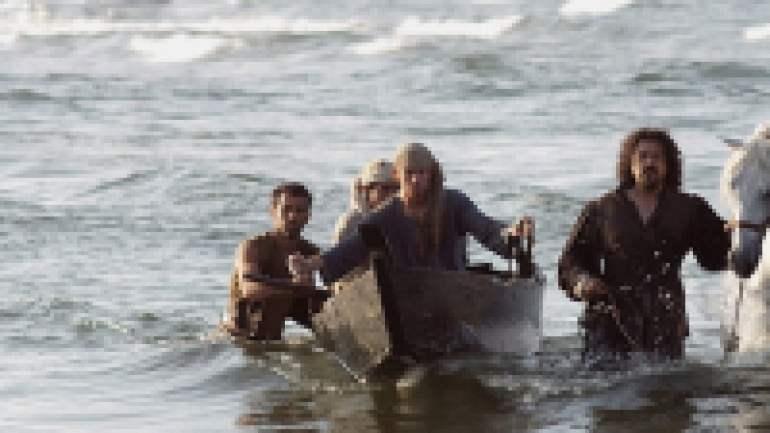History books traditionally depict the pre-Columbus Americas as a pristine wilderness where small native villages lived in harmony with nature.
But scientific evidence tells a very different story: When Columbus stepped ashore in 1492, millions of people were already living there. America wasn’t exactly a New World, but a very old one whose inhabitants had built a vast infrastructure of cities, orchards, canals and causeways.
The English brought honeybees to the Americas for honey, but the bees pollinated orchards along the East Coast. Thanks to the feral honeybees, many of the plants the Europeans brought, like apples and peaches, proliferated. Some 12,000 years ago, North American mammoths, ancient horses, and other large mammals vanished. The first horses in America since the Pleistocene era arrived with Columbus in 1493.
Settlers in the Americas told of rivers that had more fish than water. The South American potato helped spark a population explosion in Europe. In 1491, the Americas had few domesticated animals, and used the llama as their beast of burden.
In 1491, more people lived in the Americas than in Europe. The first conquistadors were sailors and adventurers. In 1492, the Americas were not a pristine wilderness but a crowded and managed landscape. The now barren Chaco Canyon was once covered with vegetation. Along with crops like wheat, weeds like dandelion were brought to America by Europeans.
It’s believed that the domestication of the turkey began in pre-Columbian Mexico, and did not exist in Europe in 1491. By 1500, European settlers and their plants and animals had altered much of the Americas’ landscape. While beans, potatoes, and maize from the Americas became major crops in continental Europe.




Very Euro-centric. Goes on about how great European livestock was. North America had skies covered with passenger pigeons, geese and all manor of migrating birds. Fish choking the rivers. Native farmers didn’t need to keep livestock; it was all around them. They managed the wilds as a garden; much more productive for less labor.
They didn’t need dung; they composted fish and vegetation.
Chestnuts, Butternuts, hickory, pecan, pinion and walnuts were thick in the forests. You know those mulberries that blacken your sidewalks every June? Those are a native cultivar.
Yes they had wars, hierarchical oppressive governments in some areas as do people everywhere. However since their ruling elite could not garner control of a fiat currency, their power was limited in scope.
The North American Indian Everyone who believe try so hard to make everyone else
believe the American Indian to be perfect. I say buffalo-chips to all that useless noise.
Their 1st guilt. War, all through their existance where one tribe wared with another tribe.
Their 2d guilt. Racism, why did the war with their neighboring tribes, the primary reason the tribe starting the war ( for whatever) HATES their opponents are of another race of Indian.
Their 3rd guilt. Slavery, the tribe invading/rading another tribes village they mudered and butchered everyone they thought to be a threat. When they subdued the village anyone left alive men, women, and children, became slaves to the conquerors.
The North American Indians; the tribe does not matter this practise took place before any Europeans showed up. I will grant that the Europeans did introduce deseases to the American Indians as well as the Indians introduced deseases to the Europeans.
The American Indians HATED the people of anothers tribe and I am suppose to believe they lived in this perfect harmony, or they lived a pristine life. Because if they live this pristine life, in perfect harmony they would have ALL banded together and and prevent the European from ever stepping off of Plymouth Rock.
They forgot to mention that they KILLED the natives, not “they were replaced”. Syphillis cannot be blamed on american indians neither it is just a claim. I find this documentary very very biased. At the same time i still found other information to be educational.
The claim that american natives were not mindful of their environment is a blatant lie. Look how quickly Europeans wiped out the vast resources in such quicker pace.
Central America is part of the North American continent.
The Aztecs in Northamerica! How many times? They are making a documentary and can’t point Central America in a map? ask Sara Pailin which countries are in northamerica. I think she knows the answer by now.
you’re really smart
Very good
too bad the Indians didnt wipe them out!
y would u want that?
its funny how we exploit the fuk out of animals..
Thanks. Really interesting doc summing up just how much the European colonization of the Americas shaped the world as it is today. Gives a great overview whilst also homing in on the crucial factors. My understanding has been increased, and that’s why I watch documentaries. Ideal!
It’s informative, but a bit all over the place. Too much reliance on melodrama and indulgence in repetitive imagery.
How wonderful ! (not) We weave a web of deciet … “They were not peaceful, they caused syphilus, we were innocent”… I think not… I thought they stopped teaching this drivel to kids in school … an abhoration of a genocidal tale that is now being told.
Manifest Destiny!